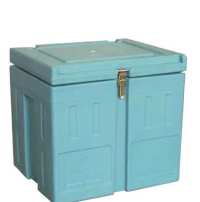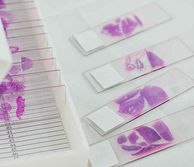Utilities
All departmental researchers have access (following induction, and where needed, allocation) to central utilities.
Theses utilities include:
 |
Central pure water systems |
 |
-80c freezers (space managed and allocated). These are temperature monitored and logged with insurers |
 |
-150ºC Cryostorage freezers |
 |
'Wet ice' Machines |
 |
Dry ice storage and provision |
 |
Glass washers |
 |
Autoclaves |
| Freeze Dryers | |
 |
Trolleys and assistance from the technical team on tranport, moving and deliveries |
The departmental utility rooms, equipment and services are dedicated spaces for sterilizing (GM waste, Instruments and media) as well as the central space for ice machines, the 3D print water Jet station and glass washing for all researchers.
The department also provides and supports 1 distilled/pure water system per floor for researchers to utilise.
Items
Wear personal protective equipment:
- Lab coat
- Eye protection
- Closed-toe shoes
- Heat-resistant gloves to remove items, especially hot glassware (remember these have been at 121c!)
Packaging and Loading
- Only designated individuals should be allowed to set and/or change parameters for the autoclaves.
- Before using the autoclave, check inside for any items left by the previous user that could pose a hazard.
- Clean the drain strainer before loading the autoclave.
- Always place items in a secondary container.
- Do not overload or package bags too tightly. Leave sufficient room for steam circulation. If necessary, place container on its side to maximize steam penetration and avoid entrapment of air.
- Use only autoclavable bags to package waste.
- Do not allow bags to touch the interior walls of the autoclave to avoid melting of plastic.
- Ensure sufficient liquid is packed with contents of autoclave bags if dry.
- Place soiled glassware and lab ware in secondary containers and autoclave them in the solids cycle. Do not fill containers more than 2/3 full with liquids. Loosen caps or use vented closures.
 Ensure to mark with autoclave tape to indicate steralisation (note the print out is the official record and MUST be checked)
Ensure to mark with autoclave tape to indicate steralisation (note the print out is the official record and MUST be checked)
- In case of clean glassware and wrapped instruments, lay them in a secondary container before autoclaving in wrapped goods cycle.
- For secondary containment, use autoclave trays made out of polypropylene, polycarbonate or stainless steel. The trays should have a solid bottom and sides to contain the contents and catch spills.
- Choose appropriate cycle for the material. Incorrect selection of cycle may damage the autoclave, cause liquid to boil over or bottles to break.
- Start your cycle and fill out the autoclave user log. A completed cycle usually takes between 1 to 1.5 hours.
- Check chamber/jacket pressure gauge for minimum pressure of 20 pounds per square inch (psi).
- Close and lock door.
- Check temperature for 121⁰C every load.
- Do not attempt to open the door while autoclave is operating.
Unloading
- Ensure cycle has completed and both temperature and pressure have returned to a safe range.
- Wear PPE described above, plus an apron and face shield if removing liquids. Stand back from the door as a precaution and carefully open door no more than 1 inch. This will release residual steam and allow pressure within liquids and containers to normalize.
- Allow the autoclaved load to stand for 10 minutes in the chamber. This will allow steam to clear and trapped air to escape from hot liquids, reducing risk to operator.
- Do not agitate containers of super-heated liquids or remove caps before unloading.
- Place liquids in an area which clearly indicates the items are “hot” until the items cool to room temp.
- Allow autoclaved materials to cool to room temperature before transporting. Never transport superheated materials.
- Place cooled autoclaved biohazard bag into regulated medical waste box. Autoclaved infectious liquids may be disposed of into the sanitary sewer.
Recordkeeping:
Autoclave Log:
An autoclave log containing the following details should be maintained by researchers as directed with the technical staff:
- Date, time, and operator’s name
- Contact information: Laboratory, room number, phone number
- Type of material sterilized/cycle
- Temperature, pressure, and length of time the load is sterilized.
LAB AUTOCLAVE BEFORE THE CYCLE
- Make sure all users are trained prior to operating any autoclave. Users must be trained and logged on the offical insurance register.
- Only load materials that are compatible with the autoclave.
- Before loading containers of liquids into the autoclave, loosen the caps.
- Ensure any bags are slightly open to allow steam to penetrate and steralise
- Ensure that the autoclave door is closed and locked before beginning the cycle
AFTER THE CYCLE
- When the cycle is complete, open the door cautiously.
- Do not remove items from an autoclave until they have cooled completely.
- Wear appropriate personal protective equipment, including a lab coat, eye protection, closed-toe shoes, and heat-resistant gloves to remove items.
- Use forceps or other tools to remove sharp instruments from autoclaves.
Autoclaves provide a physical method for disinfection and sterilization. They work with a combination of steam, pressure and time. Autoclaves operate at high temperature and pressure in order to kill microorganisms and spores.
- To be effective, the autoclave must reach and maintain a temperature of 121° C for at least 30 minutes by using saturated steam under at least 15 psi of pressure. Increased cycle time may be necessary depending upon the make-up and volume of the load.
- The rate of exhaust will depend upon the nature of the load. Dry material can be treated in a fast exhaust cycle, while liquids and biological waste require slow exhaust to prevent boiling over of super-heated liquids.
Material |
Recommended for: |
|
Liquids cycle(Slow Exhaust) |
Use with glass containers with vented closures; 2/3 full only •Liquid media •Nonflammable liquids •Aqueous solutions •Liquid biological waste |
|
Solids or Dry cycle(Fast Exhaust) |
|
|
Wrapped Goods or Pre vacuum cycle(Clean: Fast Exhaust Dirty: Slow Exhaust) |
|
|
AUTOCLAVE-COMPATIBLE MATERIALS |
AUTOCLAVE-INCOMPATIBLE MATERIALS |
|---|---|
|
|
Never autoclave:
· Flammable, reactive, corrosive, toxic or radioactive materials
· Household bleach
· Any liquid in a sealed container.
· Any material contained in such a manner that it touches the interior surfaces of the autoclave.
· Paraffin-embedded tissue.
Glass
- Only Pyrex® or Type I borosilicate glass is autoclavable. When autoclaving liquids in Pyrex® containers, do not fill more than 2/3 full and do not seal the container.
Plastic
- Polypropylene is an inexpensive resin that can resist autoclave temperatures. Polypropylene containers are often used as secondary containers to hold materials that are autoclaved. Polycarbonate can also withstand high temperatures. Polystyrene (PS), polyvinyl chloride (PVC), nylon, acrylic, low-density polyethylene (LDPE), and high-density polyethylene (HDPE) lab ware and polyurethane tubing are not autoclavable under any conditions.
Gloves
- Gloves must be placed inside of an autoclavable biohazard bag and exposed to a steam setting; gloves will melt slightly but will not burn when autoclaved in this manner.
Stainless steel
- Most metals are designed for extreme conditions and are intended to be sterilized. Make sure to remove any plastics, liners and other items that may melt or combust.
Paper
- Paper is combustible and should not be placed directly inside an autoclave. It should be autoclaved in a waste bag on a biobag setting to prevent fire.
Media Solution
- No liquid should be sealed in a container and autoclaved. Fill 2/3 of the container and loosen caps. They should autoclaved in a steam producing cycle.
Pipette tips
- Most pipette tips are autoclavable. Some of these tips are plastic, some are high density polyethylene. In general, pipette tips should only enter the autoclave as waste inside of an approved biohazards bag and always sterilized on a steam-producing setting.
OtherFacilities
Facility contact
Nana A. Asamoah-Danso, (n.asamoah-danso@imperial.ac.uk)
B211, 2nd Floor, Bessemer Building, South Kensington Campus
Tel: TBC






